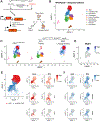Single-Cell Transcriptomic Profiling of Vascular Smooth Muscle Cell Phenotype Modulation in Marfan Syndrome Aortic Aneurysm
- PMID: 32698686
- PMCID: PMC7484233
- DOI: 10.1161/ATVBAHA.120.314670
Single-Cell Transcriptomic Profiling of Vascular Smooth Muscle Cell Phenotype Modulation in Marfan Syndrome Aortic Aneurysm
Abstract
Objective: To delineate temporal and spatial dynamics of vascular smooth muscle cell (SMC) transcriptomic changes during aortic aneurysm development in Marfan syndrome (MFS). Approach and Results: We performed single-cell RNA sequencing to study aortic root/ascending aneurysm tissue from Fbn1C1041G/+ (MFS) mice and healthy controls, identifying all aortic cell types. A distinct cluster of transcriptomically modulated SMCs (modSMCs) was identified in adult Fbn1C1041G/+ mouse aortic aneurysm tissue only. Comparison with atherosclerotic aortic data (ApoE-/- mice) revealed similar patterns of SMC modulation but identified an MFS-specific gene signature, including plasminogen activator inhibitor-1 (Serpine1) and Kruppel-like factor 4 (Klf4). We identified 481 differentially expressed genes between modSMC and SMC subsets; functional annotation highlighted extracellular matrix modulation, collagen synthesis, adhesion, and proliferation. Pseudotime trajectory analysis of Fbn1C1041G/+ SMC/modSMC transcriptomes identified genes activated differentially throughout the course of phenotype modulation. While modSMCs were not present in young Fbn1C1041G/+ mouse aortas despite small aortic aneurysm, multiple early modSMCs marker genes were enriched, suggesting activation of phenotype modulation. modSMCs were not found in nondilated adult Fbn1C1041G/+ descending thoracic aortas. Single-cell RNA sequencing from human MFS aortic root aneurysm tissue confirmed analogous SMC modulation in clinical disease. Enhanced expression of TGF-β (transforming growth factor beta)-responsive genes correlated with SMC modulation in mouse and human data sets.
Conclusions: Dynamic SMC phenotype modulation promotes extracellular matrix substrate modulation and aortic aneurysm progression in MFS. We characterize the disease-specific signature of modSMCs and provide temporal, transcriptomic context to the current understanding of the role TGF-β plays in MFS aortopathy. Collectively, single-cell RNA sequencing implicates TGF-β signaling and Klf4 overexpression as potential upstream drivers of SMC modulation.
Keywords: Marfan syndrome; aortic aneurysm; extracellular matrix; phenotype; transcriptome.
Conflict of interest statement
Disclosures
The authors confirm that there are no financial disclosures or conflicts of interest.
Figures








References
Publication types
MeSH terms
Substances
Grants and funding
LinkOut - more resources
Full Text Sources
Medical
Molecular Biology Databases
Miscellaneous

